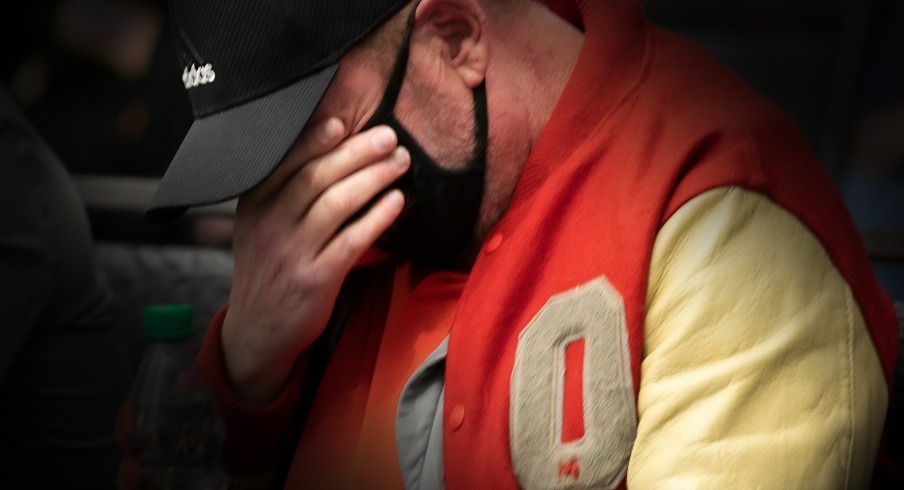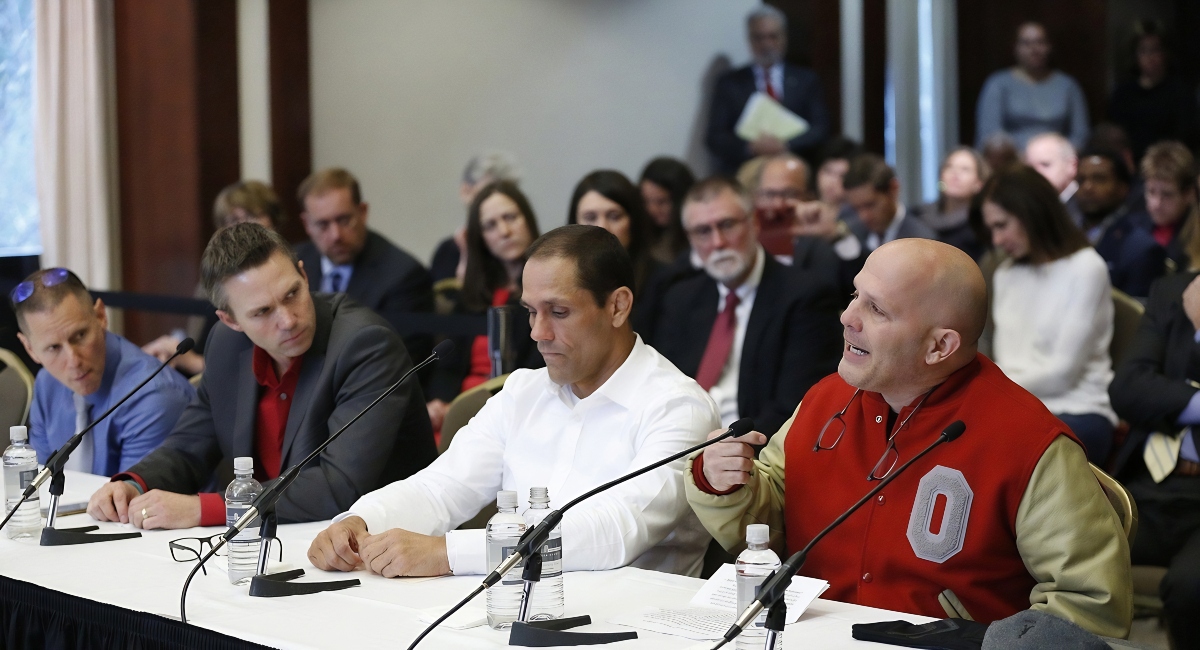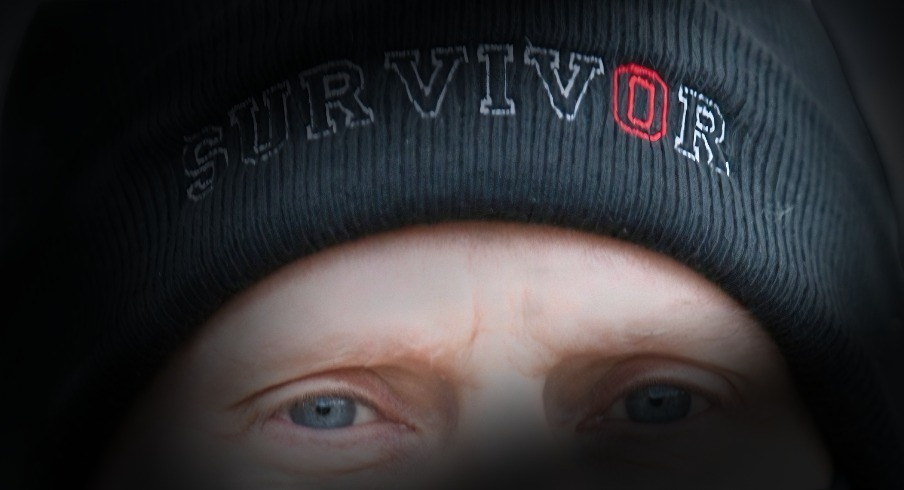Ohio State earns the No. 2 seed in the CFP, will face Texas A&M or Miami in the quarterfinals.
Some things you just feel better not knowing.
A lesson which may have gone forever unlearned for me were it not for the advent of social media. It collided 20 years ago with an unrelenting curiosity I developed as a child and got the dopamine flowing in a way which made it indispensable to my daily routine.
Then about a decade ago, too much of that dopamine flipped to cortisol. So many horrible people, horrible developments, horrible events - all elements which our social media-deprived hunter-gatherer ancestors dealt with as well, but now spewing directly toward me from all over the globe onto the information theater's main stage.
The customizable digital age made it all just a little too personal. My social media consumption has since plummeted as I've replaced Unrelenting Curiosity with Just Be Curious Enough.
Some horrors still demand investigation, because horrors don't go away just because we tune them out. And some of us don't have the privilege of getting to ignore them. This is not a story you want to read just as much as it's not one I prefer to write.
But I think we owe it to ourselves to be part of a humanity shift that can recognize when something we just feel better not knowing is actually something we should bring more attention to. Some horrors are not one-time lessons. They're like bacteria, which never stop replicating, are often hard to see and require constant monitoring.
trigger warnings: sexual assault, suicide
Dr. Richard Strauss was the Ohio State assistant professor and team physician who was found to have molested at least 177 male students starting in 1979 up until his retirement in 1998. Seven years ago I wrote about a then-activated postmortem investigation, but not on account of unrelenting curiosity. That one felt more like an obligation.
First, I knew one of his victims. Ohio State wrestler Michael DiSabato, a big-hearted, outspoken, renown axe collector and grinder whose enthusiasm for his causes (e.g. supporting every type of wrestling you've ever heard of, destroying the concept of amateurism) was and still is inexhaustible.
His story was important and relevant to share because it involved OSU athletics and serial molestation which was alleged to be widely known for years but undeterred by administration. Prior to publishing it, I expected to hear from a certain element how my choice to research, write and share that story was fueled by politics, because US Congressman Jim Jordan was an Ohio State assistant wrestling coach from 1987-1994.
Jordan's role, position and the oxygen the story received from some journalists and media creators at the time was undeniably motivated by politics. But there are more than a few places where that accusation falls apart, at least toward me and the work this site publishes. It's explicitly outside of the mission for this media company and its community.
A sitting congressman being a part of an Ohio State scandal was more inconvenient to survivor stories and their deferred recourse than helpful. It made the whole affair very easy for too many people to dismiss on account of political bias. Strauss' crimes and the wide berth he was given to athletes' bodies would be a lot easier to address if Jordan wasn't an active part of what happened.
Seven years earlier I published a story here about how Jerry Sandusky was given a sanctuary by Penn State for decades to assault the children of his choosing. A year later I wrote about how empty Monday Morning Quarterbacking what you would have done to stop Sandusky was, in a culture that prioritized the institution over humanity and put everything including the whistleblower's livelihood at risk.
No politicians were harmed. It was another B1G institution as well, so there was no rebuttal.
Earlier in 2018 I wrote about how a Michigan State physician was able to consistently molest his patients who were not anonymous, disposable children - but quite literally America's Sweethearts. Had he been selling unlicensed Olympic or Michigan State merchandise, his operation wouldn't have lasted a month. It's how institutions are oriented, toward stakeholder primacy.
Three years later, a similar horror story in Ann Arbor on a scale that is almost unquantifiable. They're stories you and I would just feel better not knowing, but on account of preserving humanity that's close to home - we should Just Be Curious Enough. Again and again, no political parties were implicated.
This past summer, Indiana men's basketball and late coach Bob Knight entered the realm where these stories keep accumulating. Coaching legends and administrators who failed to do what is required from leaders, time and time again.
So, skip the Ohio State version of this horror story because of politics? I considered it.
STAYING QUIET ABOUT what Strauss was allowed to do at Ohio State is exactly what Strauss himself would have wanted.
It's definitely safer. Being online and writing under my government name makes me an easy target for readers who object to my content, whether it's about actual crimes or underperforming coaches. Speaking of that name, some readers cannot help but launch into xenophobic seizures when they see it, either in my inbox or social media mentions. That reality is content-agnostic. I stopped being curious about those readers a long time ago.
Invoking an active politician in the Strauss story extends that target to well beyond our cozy sports ecosystem. So yeah, writing about the disparity of holding penalties called on Ohio State's opponents vs. most of the other FBS football programs is a lot easier.
Some things you just feel better not knowing. But sequestering what Strauss was allowed to do at Ohio State is exactly what widened his pipeline of victims which extended for decades. It's what Strauss himself would have wanted. He's whom everyone is unified and agrees was the worst bad guy in this story.
Just Be Curious Enough. Part of my privilege here is greenlighting my own story topics.
So back in 2018, I stuck to public records requests and DiSabato's testimony, published the story and that was the end of it. I had been Curious Enough about something I would have felt better not knowing about at all.
Hopefully, the survivors would be able to find some sort of closure and a fair settlement in a country governed by laws. And hopefully a handful of readers learned something about the courage needed to prevent a never event from occurring.
But then, the story refused to leave me alone. DiSabato and I would chat for hours about the aftermath as it was happening in real time. I began hearing from people who were one degree separated from a football player whom Strauss had examined - a knee contusion that turned into a genital exam.
A gymnast from their high school with a rotator cuff injury who ended up alone with Strauss in an examination room receiving a genital exam. A hockey player from down the street...you get the idea.
Then, actual victims who were at Ohio State during Strauss' tenure. And then I started hearing about guys I grew up with who had never attended Ohio State - but were having active nightmares and post-traumatic events stemming from The Bad Doctor during our childhood.
During our childhood. Strauss was not a pediatrician. And children don't attend Ohio State.

I was consumed by my own naivety about the whole affair. How could I have possibly been led to believe a serial predator had rules and boundaries that confined him to only molesting certain college students during his tenure with a single employer? My Ohio State brain had made this all about Ohio State - which, yes, was a major player in a story I'd feel a lot better not knowing.
Over this past summer, a documentary called Surviving Ohio State debuted at the TriBeCa film festival. It was produced by George Clooney and longtime Clooney collaborator Grant Heslov. I was asked to go, but had a legitimate conflict: I didn't want to.
Among the reasons I didn't want to see it was the trailer, which turned me off. Too many images of modern Ohio State campus buildings which weren't conceived when Strauss was alive. Too many visuals which felt inauthentic and overproduced. Manufacturing additional outrage for a story that invokes immeasurable, organic rage and sorrow sows doubt in the legitimacy of what took place. They didn't need to dress this up.
While advising on the 30 for 30 film on Maurice Clarett I told the producers something similar, that minute details matter to the skeptics you already have a small chance of convincing. You cannot include Etienne Sabino highlights even if it's just part of some B-roll and irrelevant to the central point. He and Clarett never played together. (they removed it, and some other stuff)
That interaction went through my head while watching a trailer which included shots of Ohio Stadium several major renovations after Strauss was hired, along with a hospital and medical infrastructure that didn't exist.
What we choose to excuse or not know about Strauss, his victims and enablers creates a little paradox inside of us. If you decided you were just going to dismiss or not know what happened, what his employer didn't do about it and its aftermath, you're choosing to stay uninformed. That's emotionally safer, at least in the moment.
If you dove into it and digested the information through an Ohio State lens, you receive a tinted version of happened. I have one of those lenses that's nearly impossible to detach and there's a good chance you do too. Is this an Ohio State story? It sure became one. I definitely wrote one seven years ago.
But then those guys I grew up with who knew Strauss from when we were kids inexplicably entered it. If you were a boy who participated in typical boy activities, you know the first part of the story well: They had just wanted to go to camp with their friends and needed a required medical clearance.
These were children who did not end up at Ohio State. They just needed the paperwork for their parents - some Part C form signed by a physician which nobody questioned that included a pre-participation physical exam. That organization had retained a local physician to conduct those exams an annual basis.
The children likely had little to no idea what was happening to them in the moment. To my knowledge, at least a couple of them didn't piece it together until Strauss' image started showing up in the news starting in 2018, after they had been to routine physician appointments as adults, or with their own children, and realized what they had been subjected to was not normal.
Like Sandusky, Nassar and Anderson, Strauss accumulated credibility for decades before abusing IT and anyone he could get his hands on.
Maybe they would have felt better not knowing. Learning that Strauss was retained by the adult caretakers of club organizations for children to conduct what one of them described as a lineup of 11 and 12 year-olds in their underwear for his annual 'hernia and sniff' exam makes it easy to forget about political parties or university affiliations.
The filmmakers, if they even knew about Strauss' off-campus predatory activities probably would have considered that part of the horror story they were producing to be out of scope. Or perhaps a little too unpleasant for filmmaking. Even the documentary about Sandusky ended up sportswashing a lot of its scenes. How else are you going to keep the casuals in your audience invested for 100 minutes?
Storytelling is finicky, because unproduced facts aren't consumed the way stories with thoughtful production are. It's a major reason why the news is incredibly hard to trust or take seriously in 2025. We need to be interested. Sexual assault and rape can't be the main character in a story about sexual assault and rape.
The bystanders who allowed it to happen add the necessary intrigue to that story telling. They all worked for the same institution, which creates just enough conspiratorial odor to be the hook. They congregated in stadiums on Saturdays. They congregated in churches on Sundays. They congregated in Congress. Now you're invested. Sexual assault and rape are just the stage props now.
This wasn't an isolated incident or past-tense. Any institution invested in self-preservation will cloak itself in legitimacy to protect itself both right now and in the future. The most dangerous actors are the legitimate ones, like Strauss - who didn't need to manufacture any legitimacy. Ohio State didn't have to do that for him on his behalf either.
He accumulated prestige at University of Chicago, the Medical Corps of the United States Navy, University of Washington and in the Ivy League at Penn before arriving in Columbus.
Strauss was cloaked in legitimacy that opened doors from Larkins Hall to organizations for children in Columbus communities. His continued and protected affiliation at the university preserved that access and cast doubt on any accusation about him, both the whispered kind and the complaints that were formally made to university administrators.
Like Sandusky, Nassar and Anderson, Strauss accumulated credibility for decades before abusing that credibility as well as anyone he could get his hands on. If you have no ties to Ohio State and look at how Strauss was allowed to operate through your political leanings, you might fall for the idea that this was the story of the man who allowed it all to happen prior to climbing the ranks of a political party.
It was deemed more attractive to make this a Bad Politician story outside of Columbus - so guess what started happening right as the film was being promoted. Closer to home, it's more of an Ohio State story despite Jordan serving Ohio's 4th district.
Both stories are true; just not one or the other. Choosing to believe - or dismiss - the one which instills more righteous anger is a trick we play on ourselves that doesn't address a single problem.

Strauss had the freedom to operate in places where he never should have been allowed to go, whether it was campus examination rooms or the Columbus suburb where I grew up. I would feel better not knowing any of that. But I know Nassar and Sandusky will both die in prison, while Anderson and Strauss are already dead.
There are more predators like them and more to follow the same paths they took to do what they all did for decades. Just Be Curious Enough. We can't eliminate sexual predators from existing. We can reduce their numbers and devastation.
The clickiest garbage on the Internet resides inside a vortex which began as something quite real, whether it's another school shooting or a sex scandal. Sensationalized, slanted grift and outright fabrications all swirl and obfuscate, twist or misrepresent authentic horror stories.
when a monster shows up, hoping it just goes away has not proven to be effective anywhere.
Get your audience riled up and passionate and now you've got a degree of influential power. We have plenty to be outraged about in 2025, but the problem with that type of energy is that it's an effective instrument in manipulating behavior, no matter how pervasive and diluted it is in the social media age.
Deciding what to care about and what to ignore is a personal choice. I cannot tell you how you should feel about the fact that (at least) hundreds of Ohio State students were molested, assaulted and raped by a member of the medical faculty over the course of many years, and that so many people including coaches and administrators were told about it.
I don’t know how to tell you that you should care about people you don't know without sounding preachy or condescending, especially since I have built my own mute filter around the news to prevent me from drowning in cortisol. I definitely won’t tell you to see a flawed and incomplete documentary that covers a sliver of what Strauss did through an extremely limited lens.
Surviving Ohio State now streams everywhere, including on a United flight I took last week.
Which was where I finally watched it, start to finish, 33,000 feet above the earth. After having too many reasons and conflicts preventing me from seeing it, I decided this was one of those horrible things that justified being Curious Enough. And I found that it didn't go far enough for the survivors, on account of being limited by a myopic vision and, to be fair, scarce on-the-record testimony.
One of its most jarring elements is the number of men slightly older than I am looking directly into the camera without visual or voice modifications to obscure their identities, breaking down while describing what happened to them decades ago. Some of them, like DiSabato are wearing their Ohio State letterman jackets.
They solemnly finish their statements with Go Bucks or O-H after having just described the worst moments of their lives. I cannot tell you how to process that. Outrage can be cynical, misdirected, devastated or just loud. I watched for 108 minutes and came away debating whether it should have attempted to go deeper or wider. Through an Ohio State-scandal lens, probably deeper.
But if you were one of the guys I grew up with who don't exist and are completely unacknowledged in any of the stories about Strauss, you can guess what they think of Surviving Ohio State. Sexual assault victims were as useful as they were disposable of a device to create a specific and directed type of outrage.
Similar to what took place at Penn State, Michigan State and the University of Michigan - I cannot tell you that whatever you think you would have done if you had the hypothetical opportunity to stop Strauss is believable or doubtful. I know this keeps happening and that bystanders in institutions like those all behaved similarly.
I know that when you're a teenager with a sprained knee, a dislocated finger, a tweaked ankle or a low-grade fever - and the official team doctor administers a lengthy hernia exam every time you see him, maybe you decide you just don't know how medicine works and trust the guy in the white coat. Most of them are excellent.

That's a big part of the deficit we have today with trusting experts. Sandusky was a well-respected coach. Strauss, Nassar at Michigan State and Anderson at Michigan were all board-certified physicians. Sandusky ran a children's charity. Nassar worked with USA Gymnastics. Anderson worked for the Federal Aviation Administration. They abused, assaulted and raped people everywhere they worked.
Doctors go to school for a decade, so perhaps you just don't know what you don't know. You are unsure how to ask without feeling stupid or ashamed, which in the documentary is the same story retold with different words through various shaking voices. We don't have a high level of medical or health literacy, even as adults.
When the legal system takes several years to address claims and damages, creating a timeline which extends beyond the lifespans of the accused, several plaintiffs and some of the defendants - that's just the pace of proceedings. Cynically, it may be a strategy to extend beyond the statute of limitations. We don't have a high level of legal system literacy, even as adults.
Strauss has now been dead for 20 years. Determined cowards and reluctant bystanders forfeited numerous opportunities to become the heroes of that story, leaving the survivors as the only ones who can still triumph from all of this.
Triumph can just be surviving. One of those kids I grew up with who wasn't "in scope" of Surviving Ohio State because Strauss molested him off campus when he wasn't yet a teenager took his own life over the summer. I cannot tell you why. I can tell you that he did not like or appreciate the documentary.
Some horrors still demand investigation, because horrors don't go away just because we tune them out. And some of us don't have the privilege of getting to ignore them. This is not a story you want to read just as much as it's not one I prefer to write.
But I think we owe it to ourselves to be part of a humanity shift that recognizes and acts when something we just felt better not knowing becomes something we have to bring more attention to. It cannot be everything, because that's overwhelming.
It does not have to be too complicated. I cannot tell you exactly what needs to be done without sounding self-righteous or condescending. I can tell you that when a monster shows up, hoping it just goes away has not proven to be effective anywhere.
Quickly identifying and removing them is hard. But it's easier than waiting for them to leave.

